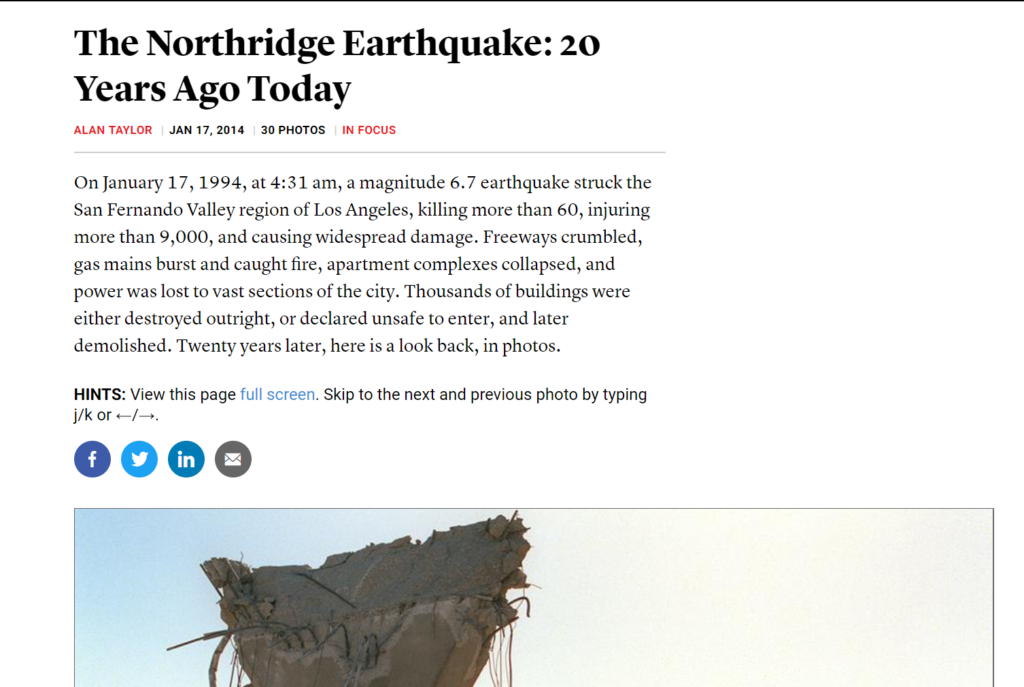We all know that earthquakes are a hazard to living in California. Most of us tend to ignore that reality unless we feel the shake, rattle and roll of an earthquake happening under our feet. Growing up I always heard that “The Big One” could happen any time. The reality is – it’s only a matter of time before an earthquake of substantial magnitude hits.
As much as we know all of the information, however, we’re often lax at putting that information into action steps to actually prepare for an earthquake. With the recent swarm of earthquakes occuring in Southern California (Click here to read this LA Times article), this is a good time to remind everyone about earthquake safety – especially while on the job.
The Northridge quake devasted the San Fernando Valley and surrounding areas. In 2014, The Atlantic published an amazing photo spread of the destruction. https://www.theatlantic.com/photo/2014/01/the-northridge-earthquake-20-years-ago-today/100664/
If you need some motivation to get prepared, read the article.

We need to periodically remind ourselves, and our employees, to prepare for the eventual earthquake. The question isn’t “if” it is only “when.” Encourage your employees to have personal plans in place and to purchase supplies for their families.
Here are some basic steps to put into place before a disaster occurs.
Walk-through the Office
Each employee should review their work station to be sure it complies with the following minimum company safety rules to help prevent earthquake injuries and/or damage:
- Remove plants, books and other heavy objects from areas above shoulder level.
- Secure TVs, computers, file cabinets, etc., to walls, desks, etc.
- Check electrical and computer cables to be sure they are not obstructing the exit pathways. Tape down in needed. Monitor the electrical connections to ensure they aren’t overloaded.
- Keep aisles clear to ensure a safe path in case of an emergency evacuation.
All employees need to familiarize themselves with the most direct exits. Everyone should have a plan to evacuate to a safe location outside of the building. Employees should all gather together at a safe location outside away from buildings and power lines. Employees should know (and review) the plan on regular basis. Include the plan in the onboarding process as well.
6 Steps to Earthquakes/Earthquake Drills
- Alarm – You may want to consider having a specific alarm when an earthquake occurs. If so, make sure everyone knows and understands what to do when the alaram sounds or when an earthquake occurs.
- Response – Everyone should Drop, Cover, and Hold On during the quake. Get under a heavy desk or table; cover your head with your arms. Avoid glass, windows, and light fixtures.
- Evacuation – Everyone should exit the building following pre-planned routes and meet in the identified location. Do not run! Walk quickly but safely. Do not panic.
- Assembly – Everyone should gather in workgroups
- Roll Call – Identify everyone who is in the work group. If anyone is missing, verify their location. Contact emergency if needed.
- Evaluate – For an earthquake drill, evaluate the process: Discuss what happened, what needs to be changed for next time. If it was an actual earthquake, determine if the building is safe to return to work or not. Determine what the logical next steps are to take. If you smell gas, shut off the main valve. In case water is running and the lines were broken during the earthquake, shut off the main valve. If you see any electrical shortages, shut off the electricity at the main meter box. Do not make any telephone calls except in case of emergency. The telephone systems will be overloaded with calls.
Want more support? Check out this pdf on 7 Steps to a Disaster Resilient Workplace: http://www.earthquakecountry.org/library/7_Steps_to_a_Disaster_Resilient_Workplace.pdf
And here’s FEMA’s Business Emergency plan:
